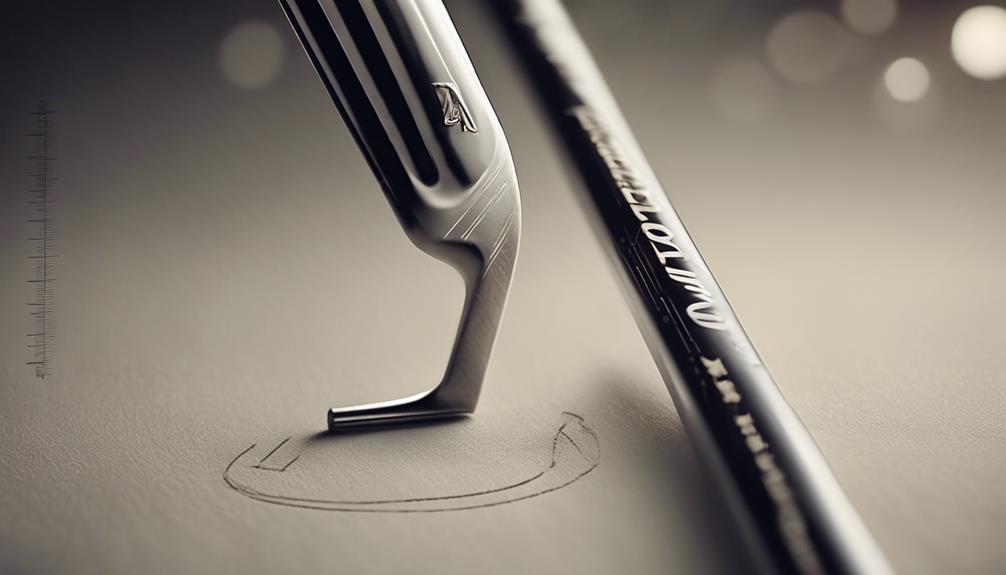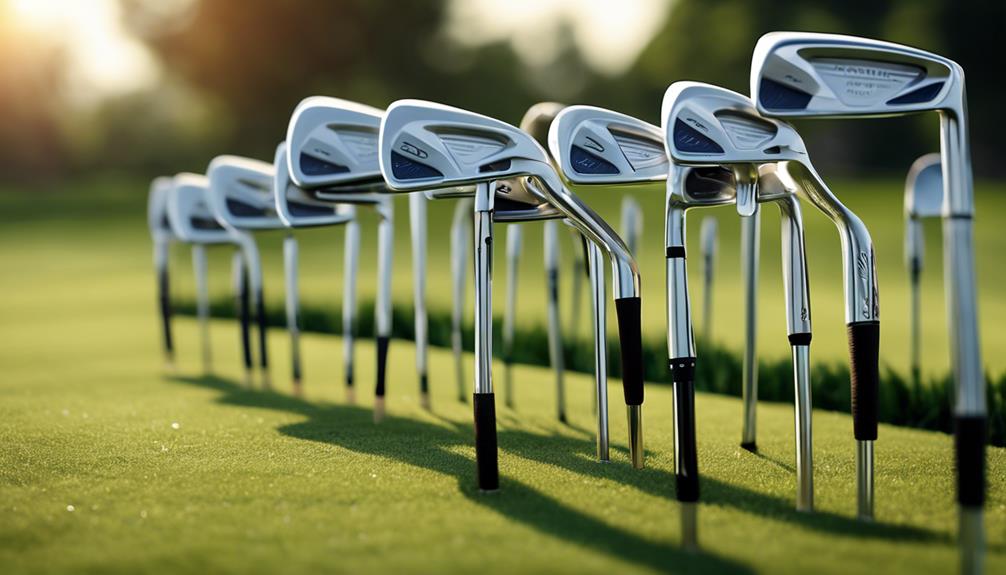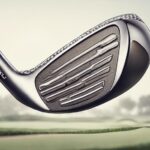- 7 Top Flite Golf Clubs XL for Improved Performance - September 28, 2024
- Top Flite Golf Clubs: Top 5 Reasons to Choose Them - September 28, 2024
- Top 3 Golf Club Fitters for a Perfect Swing - September 28, 2024
You're familiarizing yourself with the world of golf clubs! There are five primary types of clubs: woods, designed for long-distance shots; irons, ideal for precise shots from varying distances; hybrids, combining features of woods and irons; wedges, specialized for short-distance, high-precision shots; and putters, for rolling the ball on the green. Each type is engineered for specific playing conditions, enhancing your overall golfing experience. As you explore these categories, you'll discover more about their unique characteristics and intended uses, and how understanding them can elevate your game to the next level.
Key Takeaways
- Golf clubs are categorized into five primary types: woods, irons, hybrids, wedges, and putters, each designed for specific shots and distances.
- Woods, including drivers and fairway woods, are designed for long-distance shots with larger, hollow clubheads.
- Irons, numbered from 3-iron to 9-iron, are ideal for precise shots from varying distances with smaller clubheads.
- Hybrids combine features of woods and irons, providing versatility for longer approach shots and easier hitting.
Understanding Golf Club Types
When you step onto the golf course, understanding the different types of golf clubs at your disposal is essential, as each club is designed to serve a specific purpose in your game. The various types of golf clubs available can be overwhelming, but mastering their uses is vital for improving your overall performance.
There are five main categories of golf clubs: woods, irons, hybrids, wedges, and putters. Golfers use these different types of clubs to tackle distinct shots and situations.
Woods, including drivers and fairway woods, are designed for long-distance shots, while irons are ideal for precise shots from varying distances. Hybrids combine the features of woods and irons, providing versatility and ease of use.
Wedges, which include pitching, sand, gap, and lob wedges, are specialized irons for short-distance shots requiring high precision and control around the greens.
Understanding the unique characteristics and uses of each type of club will help you navigate the course with confidence and precision. By familiarizing yourself with the different types of golf clubs, you'll be better equipped to tackle any shot that comes your way.
Club Construction and Design
As you hold a golf club in your hands, the intricate design and construction of its various components come together to deliver a precise and powerful swing.
The club head, hosel, and ferrule work in harmony to create a balanced and efficient club.
Here are three important components to focus on:
- Club heads: Made from advanced materials, they vary in design, with woods having larger, hollow shapes and irons being smaller and often referred to as blades.
- Hosel: A vital component that connects the club head to the shaft, affecting the club's balance, feel, and power.
When selecting a club set, consider the construction and design of each club.
The ferrule, located above the hosel, serves as a decorative trim ring and can also function as part of the securing mechanism between the hosel and the shaft.
Shaft Specifications and Performance

As you explore the world of golf clubs, you'll find that understanding shaft specifications is essential for optimizing your game.
You'll want to take into account the composition of your shaft, whether it's made of steel or carbon fiber, which affects its overall performance.
Shaft Composition
Your golf club's shaft composition plays a critical role in your overall performance, directly impacting the feel, power, and accuracy of your swings. The materials used, such as steel or carbon fiber, greatly affect the club's performance.
Here are three key aspects to contemplate:
- Material selection: Steel shafts provide a more consistent feel and are generally heavier, while carbon fiber shafts are lighter and offer more flexibility.
- Weight and diameter: Shaft weights range from 45 to 150 grams, and diameters are typically around 0.5 inches. This affects the overall feel and performance of the club.
In addition to these factors, shaft flex, torque, and kick point also play important roles.
Shaft flex affects power and accuracy, while torque manages club head twisting for improved accuracy. The kick point defines where the shaft flexes, influencing energy storage and control.
Shaft Flexibility
Selecting the right shaft flexibility is vital, as it greatly impacts your power and accuracy, with the five main types – Lady/Womens, Soft Regular, Regular, Stiff, and Tour Stiff – catering to different swing speeds and styles.
| Shaft Flexibility | Suitable for |
|---|---|
| Lady/Womens (L/W) | Slower swing speeds (<60mph) |
| Soft Regular (A/I) | Swing speeds between 60-70mph |
| Regular (R) | Average swing speeds (70-80mph) |
| Stiff (S) | Faster swing speeds (80-90mph) |
| Tour Stiff (X) | Very fast swing speeds (>90mph) |
When choosing a shaft, consider your swing speed and style. Softer shafts provide more distance for slower swing speeds, while stiffer shafts offer better control and accuracy. Torque, which affects accuracy, is also important, as stiffer shafts experience less twisting during a swing. The kick point of a shaft, where it flexes during a swing, plays a significant role in energy storage and shot trajectory. Custom shafts can be tailored to specific launch angles and swing timings to enhance overall performance. By selecting the right shaft flexibility, you can optimize your game and take your skills to the next level.
Evolution of Golf Equipment
The transformation of golf equipment has been marked by a deliberate shift from traditional materials to innovative ones, revolutionizing the game's dynamics and elevating player performance. As you explore the evolution of golf clubs, you'll notice significant changes in materials, design, and technology.
Here are three key developments that have reshaped the game:
- Material advancements: Woods, once the primary material, have given way to steel and carbon fiber, enhancing distance and accuracy.
- Shaft innovations: Steel shafts, introduced in 1910, were initially banned but later reinstated, while graphite shafts have become popular for their lightweight and flexible properties.
These advancements haven't only improved performance but also led to changes in club design and specifications. The USGA has implemented regulations to maintain fair competition, ensuring that the evolution of golf equipment benefits the game as a whole.
As you continue to master your game, understanding the evolution of golf equipment will help you make informed decisions about the types of clubs you choose to carry.
Historical Context and Resources

As you explore the historical context of golf clubs, you'll find that the evolution of equipment is intertwined with the development of technologies and regulations that have shaped the game.
The shift from wooden shafts to modern materials like steel and carbon fiber has greatly impacted club design and construction. A pivotal moment came in 1910 with the introduction of steel shafts, which were later legalized by the USGA in 1924. Since then, the USGA has regularly updated equipment standards to adapt to new technologies, including regulations on clubhead size and performance characteristics.
Notable legal disputes, such as the one involving square grooves in Ping Eye2 irons, have also shaped the landscape of equipment manufacturing and compliance in golf.
For those interested in delving deeper into the history and regulations surrounding golf clubs, detailed bibliographies and glossaries are available. These resources provide a wealth of information on the mechanics, history, and regulations of golf clubs, allowing you to gain a deeper understanding of the game.
Club Composition and Customization
As you explore the world of golf clubs, you'll discover that club composition and customization play a vital role in optimizing your game.
You can choose from various club makeup options, tailoring your club selection to suit your swing style and preferences.
Club Makeup Options
With 14 clubs at your disposal, you can curate a customized set that suits your unique swing style and playing preferences. This is where club makeup options come into play, allowing you to select the perfect mix of clubs to optimize your game.
You'll need to contemplate the types of clubs, including woods, irons, hybrids, wedges, and putters, each designed for specific shots and situations.
Here are three key factors to contemplate when selecting your club makeup:
- Distance and accuracy: Balance is key when choosing clubs that provide the right mix of distance and accuracy for your game.
- Higher loft angles: Wedges, with their higher loft angles, are ideal for short-range precision shots, while fairway woods offer more distance and forgiveness.
Customized Club Selection
When building your customized club selection, you'll need to deliberate on the ideal club composition that harmonizes with your swing dynamics, playing style, and personal preferences. A standard golf bag can hold up to 14 clubs, but you can tailor your set to suit your needs. Consider the types of wedges you need, as they can greatly impact your short game.
| Club Type | Characteristics |
|---|---|
| Woods | High launch angles, long distances |
| Irons | Mid-to-high launch angles, precision shots |
| Hybrids | Mid-launch angles, forgiveness |
| Wedges | High launch angles, spin and control |
Custom shafts can be designed to match your swing characteristics, affecting launch angles and swing timings. Understanding the loft angles and design of each club type is essential for making informed decisions about customization and overall club selection. By balancing distance and accuracy, you can create a golf bag that complements your playing style. Take the time to experiment and find the perfect combination for your game.
Personalized Golf Sets
You can create a personalized golf set by deliberately selecting clubs that cater to your unique swing style, playing preferences, and the specific demands of your game. This allows you to optimize your performance and comfort on the course.
To create a personalized set, you can mix and match various club types, including:
- Woods: designed for long-distance shots, such as drivers and fairway woods.
- Irons: used for shots from the fairway or rough, including hybrids and traditional irons.
Customization options for golf clubs include adjustments to shaft length, flex, grip size, and clubhead design.
By understanding the unique characteristics of each club type, you can select specific loft angles and club types to suit your game. For example, you may prefer a pitching wedge for higher shots and a sand wedge for bunker play.
Golf Club Categories and Features

Four main categories of golf clubs exist, each engineered to excel in specific playing conditions and shot types: Woods, Irons, Hybrids, and Putters.
As you explore these categories, you'll discover that each type is designed to optimize your performance in distinct situations.
Woods, which include drivers and fairway woods, feature the largest clubheads and are primarily used for long-distance shots from the tee or fairway.
Irons, numbered from 3-iron to 9-iron, have smaller clubheads and angled faces, making them ideal for precise shots from the fairway or rough.
Within the Irons category, you'll find Wedges, a subset that includes pitching, sand, and lob wedges, designed for short-distance shots requiring high precision around the greens.
Hybrids, which combine characteristics of both woods and irons, provide versatility and ease of use, particularly for longer approach shots.
Finally, Putters are specialized for rolling the ball on the green, requiring a smooth, controlled stroke.
Understanding these categories and their features will help you choose the right club for the task at hand, enhancing your overall golfing experience.
Club Characteristics and Intended Use
By examining the distinct characteristics of each golf club category, you'll better understand their intended use and optimize your club selection for every shot. Each type of club is designed to excel in specific situations, and knowing their strengths will help you make informed decisions on the course.
Here are three key takeaways about club characteristics and intended use:
- Distance and Power: Woods, hybrids, and long irons are designed for long-distance shots, such as tee shots and approach shots, where you need to hit the golf ball far and straight.
- Precision and Control: Wedges and short irons are specialized for short-range shots that require precision and control, like chipping and pitching around the greens.
Frequently Asked Questions
What Is a Group of Golf Clubs Called?
You're familiar with golf club types like drivers and irons, materials like titanium and steel, and brands like Callaway and TaylorMade, but when it comes to a collection of these, you call it a "set" of golf clubs.
What Are Golf Irons Called?
As you grip your club, you're holding a precise instrument, often made of stainless steel or titanium, with varying lofts and brands like Callaway or TaylorMade, offering blade or cavity back designs, used for approach shots and precision play.
What Is a Word for Golf Club?
You'll find that a single word for a golf club is simply "club," encompassing various types, including putters, with a rich history, crafted from diverse materials, and even allowing for custom designs to suit your unique swing.
What Are Golf Groups Called?
You're wondering what golf groups are called? In golf, groups of players are called flights, typically consisting of 2-4 players, where you'll navigate golf club types, observe golf group dynamics, and exhibit golf club etiquette, all while formulating golf team strategies to maximize golf membership benefits.
Conclusion
As you wrap up your golfing journey, recall the essential cues: clever club composition, customized configurations, and cutting-edge construction.
Craft your game with precision, pairing perfectly pitched putters with powerful, propelling drivers.
Pursue peak performance, propelled by premium shafts and sophisticated swing styles.




